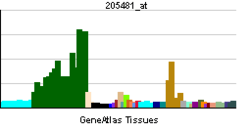Adenosine A1 receptor
| View/Edit Human | View/Edit Mouse |
The adenosine A1 receptor[4] is one member of the adenosine receptor group of G protein-coupled receptors with adenosine as endogenous ligand.
Biochemistry
A1 receptors are implicated in sleep promotion by inhibiting wake-promoting cholinergic neurons in the basal forebrain.[5] A1 receptors are also present in smooth muscle throughout the vascular system.[6]
The adenosine A1 receptor has been found to be ubiquitous throughout the entire body.
Signaling
Activation of the adenosine A1 receptor by an agonist causes binding of Gi1/2/3 or Go protein. Binding of Gi1/2/3 causes an inhibition of adenylate cyclase and, therefore, a decrease in the cAMP concentration. An increase of the inositol triphosphate/diacylglycerol concentration is caused by an activation of phospholipase C, whereas the elevated levels of arachidonic acid are mediated by DAG lipase, which cleaves DAG to form arachidonic acid. Several types of potassium channels are activated but N-, P-, and Q-type calcium channels are inhibited.[7]
Mechanism
This receptor has an inhibitory function on most of the tissues in which it rests. In the brain, it slows metabolic activity by a combination of actions. At the neuron's synapse, it reduces synaptic vesicle release.
Ligands
Caffeine, as well as theophylline, has been found to antagonize both A1 and A2A receptors in the brain.
Agonists
- 2-Chloro-N(6)-cyclopentyladenosine (CCPA).
- N6-Cyclopentyladenosine
- N(6)-cyclohexyladenosine
- Tecadenoson is an effective A1 adenosine agonist, as is selodenoson.
PAMs
- 2‑Amino-3-(4′-chlorobenzoyl)-4-substituted-5-arylethynyl thiophene # 4e[8]
Antagonists
- Non-selective
- Selective
- 8-Cyclopentyl-1,3-dimethylxanthine (CPX / 8-cyclopentyltheophylline)
- 8-Cyclopentyl-1,3-dipropylxanthine (DPCPX)
- 8-Phenyl-1,3-dipropylxanthine
- Bamifylline
- BG-9719[9]
- BG-9928[10]
- FK-453
- FK-838
- Rolofylline (KW-3902)[11][12]
- N-0861
In heart
The A1 and A2A receptors of endogenous adenosine are believed to play a role in regulating myocardial oxygen consumption and coronary blood flow. Stimulation of the A1 receptor has a myocardial depressant effect by decreasing the conduction of electrical impulses and suppressing pacemaker cell function, resulting in a decrease in heart rate. This makes adenosine a useful medication for treating and diagnosing tachyarrhythmias, or excessively fast heart rates. This effect on the A1 receptor also explains why there is a brief moment of cardiac standstill when adenosine is administered as a rapid IV push during cardiac resuscitation. The rapid infusion causes a momentary myocardial stunning effect.
In normal physiological states, this serves as protective mechanisms. However, in altered cardiac function, such as hypoperfusion caused by hypotension, heart attack or cardiac arrest caused by nonperfusing bradycardias, adenosine has a negative effect on physiological functioning by preventing necessary compensatory increases in heart rate and blood pressure that attempt to maintain cerebral perfusion.
In neonatal medicine
Adenosine antagonists are widely used in neonatal medicine;
Because a reduction in A1 expression appears to prevent hypoxia-induced ventriculomegaly and loss of white matter, the pharmacological blockade of A1 may have clinical utility.
Theophylline and caffeine are nonselective adenosine antagonists that are used to stimulate respiration in premature infants.
However, we are unaware of clinical studies that have examined the incidence of periventricular leukomalacia (PVL) as related to neonatal caffeine use. Caffeine may reduce cerebral blood flow in premature infants, it is presumed by blocking vascular A2 ARs. Thus, it may prove more advantageous to use selective A1 antagonists to help reduce adenosine-induced brain injury.
References
- ↑ "Drugs that physically interact with Adenosine receptor A1 view/edit references on wikidata".
- ↑ "Human PubMed Reference:".
- ↑ "Mouse PubMed Reference:".
- ↑ Townsend-Nicholson A, Baker E, Schofield PR, Sutherland GR (1995). "Localization of the adenosine A1 receptor subtype gene (ADORA1) to chromosome 1q32.1". Genomics. 26 (2): 423–5. doi:10.1016/0888-7543(95)80236-F. PMID 7601478.
- ↑ Elmenhorst D, Meyer PT, Winz OH, Matusch A, Ermert J, Coenen HH, Basheer R, Haas HL, Zilles K, Bauer A (2007). "Sleep deprivation increases A1 adenosine receptor binding in the human brain: a positron emission tomography study". J. Neurosci. 27 (9): 2410–5. doi:10.1523/JNEUROSCI.5066-06.2007. PMID 17329439.
- ↑ Tawfik HE, Schnermann J, Oldenburg PJ, Mustafa SJ (2005). "Role of A1 adenosine receptors in regulation of vascular tone". Am. J. Physiol. Heart Circ. Physiol. 288 (3): H1411–6. doi:10.1152/ajpheart.00684.2004. PMID 15539423.
- ↑ Fredholm BB, IJzerman AP, Jacobson KA, Klotz KN, Linden J (December 2001). "International Union of Pharmacology. XXV. Nomenclature and classification of adenosine receptors". Pharmacol. Rev. 53 (4): 527–52. PMID 11734617.
- ↑ Romagnoli R, Baraldi PG, IJzerman AP, et al. (2014). "Synthesis and Biological Evaluation of Novel Allosteric Enhancers of the A1 Adenosine Receptor Based on 2-Amino-3-(4'-Chlorobenzoyl)-4-Substituted-5-Arylethynyl Thiophene". J. Med. Chem. 57: 7673–86. doi:10.1021/jm5008853. PMID 25181013.
- ↑ Gottlieb SS, Brater DC, Thomas I, Havranek E, Bourge R, Goldman S, Dyer F, Gomez M, Bennett D, Ticho B, Beckman E, Abraham WT (March 2002). "BG9719 (CVT-124), an A1 adenosine receptor antagonist, protects against the decline in renal function observed with diuretic therapy". Circulation. 105 (11): 1348–53. doi:10.1161/hc1102.105264. PMID 11901047.
- ↑ Greenberg B, Thomas I, Banish D, Goldman S, Havranek E, Massie BM, Zhu Y, Ticho B, Abraham WT (August 2007). "Effects of multiple oral doses of an A1 adenosine antagonist, BG9928, in patients with heart failure: results of a placebo-controlled, dose-escalation study". Journal of the American College of Cardiology. 50 (7): 600–6. doi:10.1016/j.jacc.2007.03.059. PMID 17692744.
- ↑ Givertz MM, Massie BM, Fields TK, Pearson LL, Dittrich HC (October 2007). "The effects of KW-3902, an adenosine A1-receptor antagonist,on diuresis and renal function in patients with acute decompensated heart failure and renal impairment or diuretic resistance". Journal of the American College of Cardiology. 50 (16): 1551–60. doi:10.1016/j.jacc.2007.07.019. PMID 17936154.
- ↑ Cotter G, Dittrich HC, Weatherley BD, Bloomfield DM, O'Connor CM, Metra M, Massie BM (October 2008). "The PROTECT pilot study: a randomized, placebo-controlled, dose-finding study of the adenosine A1 receptor antagonist rolofylline in patients with acute heart failure and renal impairment". Journal of Cardiac Failure. 14 (8): 631–40. doi:10.1016/j.cardfail.2008.08.010. PMID 18926433.
External links
- "Adenosine Receptors: A1". IUPHAR Database of Receptors and Ion Channels. International Union of Basic and Clinical Pharmacology.
- Adenosine A1 Receptor at the US National Library of Medicine Medical Subject Headings (MeSH)

